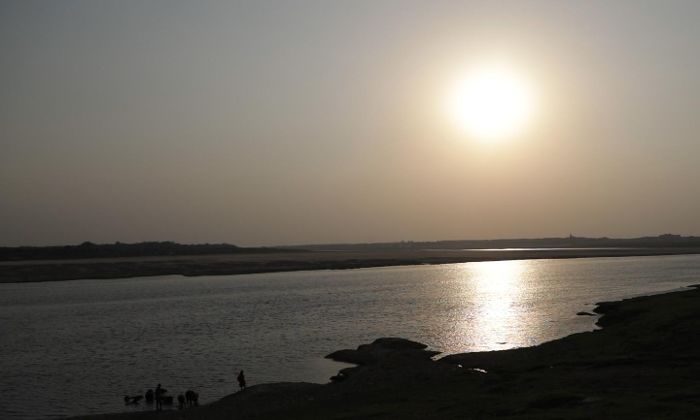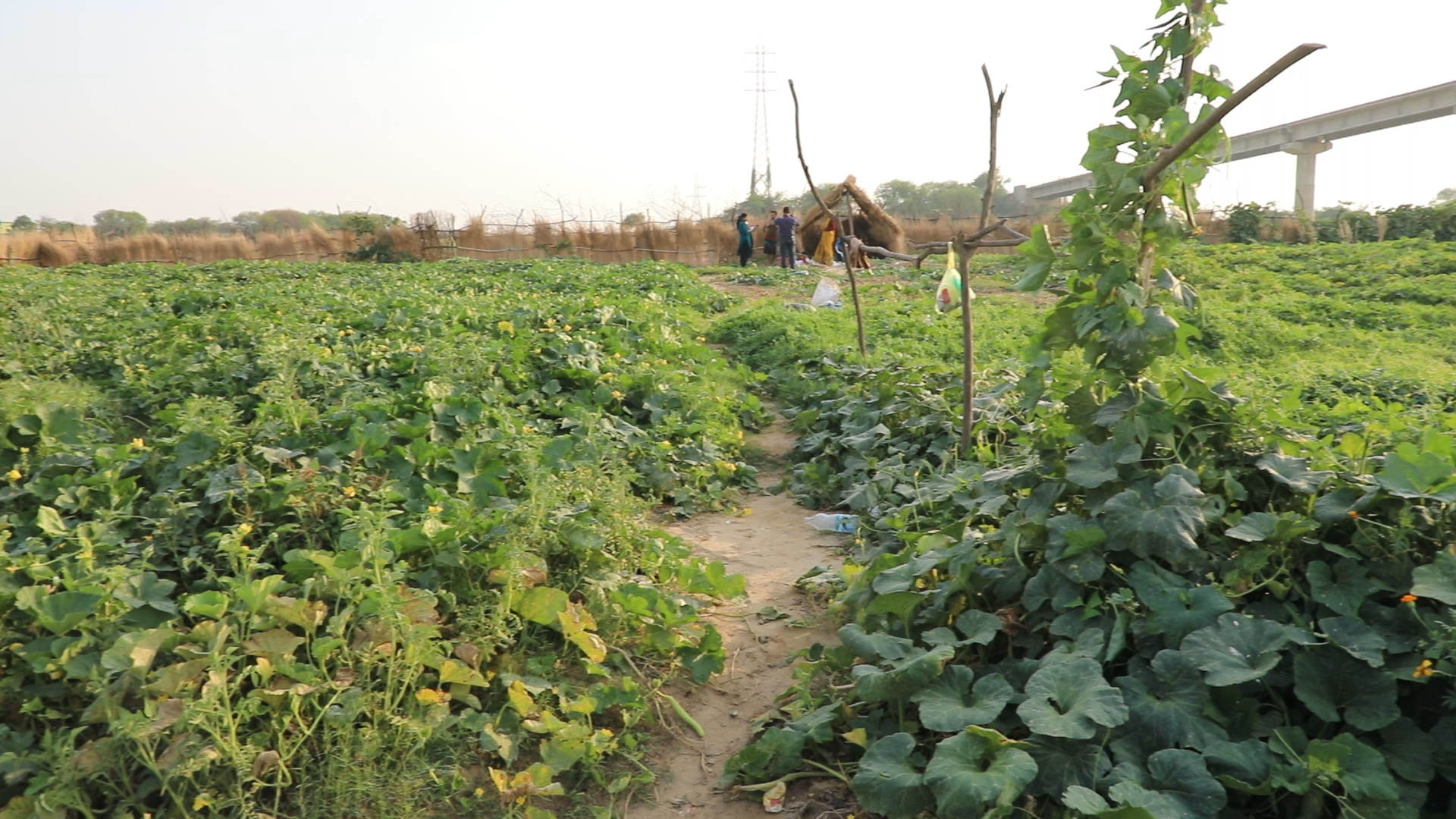Surging waters of Chambal River devour thousands of hectares of ripe crops every year
Chambal River floods thousands of hectares of cultivated land and ruins kharif crop every year. Farmers in hundreds of villages adjoining Chambal live in constant fear praying for light rains to keep away the floods.

Jaiveer Singh, a farmer from Simrai village in Uttar Pradesh, had sown 30 bighas of bajra (millet) in the kharif season last year, by mortgaging his wife’s jewellery, only to lose the entire ripe crop to floods.
“Just about to be harvested, my bajra crop was swamped by the floods in the Chambal River. All our farming efforts had been in vain when our prized yield was snatched away from us,” a despondent Singh, who resides in Simrai village of Bah block, about 80 kms away from Agra district headquarters, told Gaon Connection.
Last year, this village, which adjoins the mighty Chambal River, suffered major floods which washed away 700 bighas of ready to harvest bajra crop. Every year in Bah tehsil alone, minor flooding destroys 2,000 to 2,500 bighas of crops.
Sitting on a platform beneath a Neem tree, Singh, 55, said he had mortgaged his wife’s jewellery to take a loan to sow the crop. “I had hoped to reclaim the ornaments after the harvest. The Chambal gobbled up my crop and now we are suffering the wrath of the corona virus pandemic. I may as well forget about getting the jewellery back this year,” the farmer said. However, the loan he has to repay still stares at him.
In 1996 and 2019, massive floods in the Chambal River wreaked havoc in the region damaging millions of hectares of crops. The Chambal region is prone to mild annual floods that routinely inundate thousands of hectares of crops.

The farmer complained that there was no help from the government. “We sit and helplessly watch our ripe crops get washed away. Whom do we plead to,” Singh asked.
An official of the state agriculture department, who requested anonymity, clarified that only farmers who insured their crops under the government’s crop insurance scheme (Pradhan Mantri Fasal Bima Yojana) were compensated by the department of agriculture. “The compensation for the crops destroyed in the floods is provided under the disaster relief management and is miniscule in amount. Even this petty amount takes up years to be released,” the official said. A farmer may receive only Rs 1,000 in compensation for losses worth one lakh rupees, he added.
Simrai is not the only village which gets affected in the Chambal floods. Thousands of hectares of crop across UP, MP and hundreds of villages in Rajasthan are devoured annually by the billowing Chambal causing thousands of farmers in the region to live in fear.
This year, farmers living by the Chambal River are facing a double whammy – floods of last year and the current coronavirus pandemic crisis that has led to migrant workers returning to their villages from cities. The farmers have lost crops but have loan debts to clear and also have more mouths to feed.
Currently, Chambal and Parvati rivers flowing between the borders of Madhya Pradesh and Rajasthan are on a surge. In many parts of Madhya Pradesh, the water level of Parvati River has risen rapidly after the recent heavy rains. The Sheopur-Kota highway route was disrupted due to the flooding river flowing 10 feet above the bridge.
Life in the Chambal ravines are often viewed by the rest of the country through the lens of cinematic glamour, whereas the harsh reality is the misery the Chambal River in spate brings to the ravine farmers. The region faced both droughts and floods. In the absence of irrigation, the farmers faced an acute shortage of water, forcing many to cultivate only kharif crops. “Even then, the farmers can never be certain of the harvest because it often coincides with the Chambal floods due to which thousands of hectares of farming land is washed away in no time,” farmer Singh said.
He claimed that the farmers had never received any flood warnings from the authorities. “No one has ever given us any such information. We make our own predictions based on the rains. We pray the entire rainy season that there should be no heavy rains as less rains means chances of floods are very low and our crops are saved,” Singh said.
The agriculture department official who had requested anonymity said sometimes the water was let out suddenly and there was no time to inform the farmers. “Floods come every year, destroying thousands of hectares of crops. Although there is a high risk of loss to the farmers, there is no choice for them but to bear it and continue farming,” he told Gaon Connection.
A Gaon Connection team had toured Chambal under the ‘Corona Footprint’ series to understand the hardships of the people of Uttar Pradesh, Madhya Pradesh and Rajasthan adjoining the Chambal River during corona crisis. Local farmers spoke of their problems in the ravines like unemployment, migration, poor health services and the scourge of the Chambal River.
Satish Mishra, 52, a social worker from Jhaura village in Morena district of Madhya Pradesh, told Gaon Connection, that the acreage of cultivable and residential land was fast turning into sandy plateaus and hilly dunes. “The local people are forced to migrate elsewhere. The massive soil erosion due to Chambal, Kwari, Sindh, Asan and Parvati rivers is causing vast amount of sandy land to cave in under the strong river current,” he told Gaon Connection.
“Every year, these floods affect 200-250 thousand hectares of land. The government should formulate a strategy to prevent thousands of hectares of crop being wasted due to the floods of Chambal River and the villages becoming uninhabited, ” Mishra said.

Thousands of farmers from across districts like Sheopur, Morena, Etawah, Dhaulpur and Datia continued to suffer due to lack of help from the government, according to farmers.
India is the world’s leading bajra producer, grown in about 85 lakh hectares area across the country, with about 87 per cent cultivation by Rajasthan, Maharashtra, Gujarat, Uttar Pradesh and Haryana.
Pintu Lal Meena, assistant agriculture officer of Sarmathura at Dhaulpur, told Gaon Connection on phone, that the authorities issued alerts immediately on getting flood warnings. “People are shifted to safer places. We also issue an advisory to the farmers to keep the land which falls in the flood area vacant and not to cultivate it.”
Asked about compensation in case the crops were destroyed in the floods, Meena said those farmers who were not registered under the Pradhan Mantri Fasal Bima Yojana, were provided relief under the disaster relief management.
“Cultivation along the Chambal River means a life of constant worry for the farmers,” Bharat Singh Lodha, a member of the Bharatiya Kisan Sangh and a resident of Lohari village in Dhaulpur district of Rajasthan, said. “It is more difficult to cultivate here than most other places,” he added.

